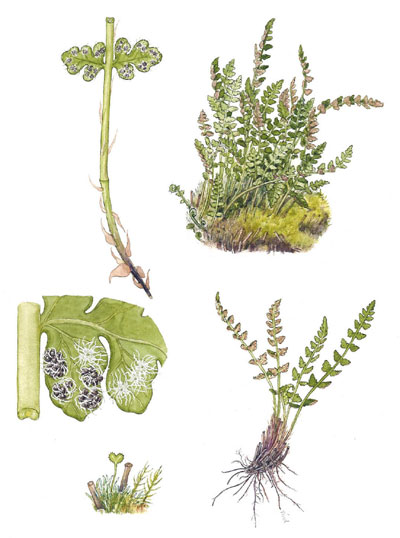| Woodsia alpina | ||
Alpine woodsia, alpine cliff fern, northern woodsia | ||
|
Etymology
From the Latin alpinus, meaning alpine.
Description
Rhizome: erect, compact, with abundant persistent petiole bases of � equal length, scales uniformly brown, lanceolate.
Frond: 15 cm high by 2 cm wide, deciduous, monomorphic, blade/stipe ratio: 2:1 to 3:1. Stipe: persistent base, brown or black when mature, articulate above base at swollen node half way up the stipe, red-brown lanceolate scales at the base, diminishing upwards, vascular bundles: 2, round or oblong. Blade: 1-pinnate-pinnatifid, barely so, narrowly lanceolate to ovate-lanceolate, broadest below middle, herbaceous, bright green, long fine, red-brown hairs. Pinnae: 8 to 15 pair, largest pinnae with 1--3 pairs of pinnules, the shorter ones merely fan-shaped; costae grooved above, grooves continuous from rachis to costae; margins nearly entire; veins free, simple or forked. Sori: round, near the margin, indusium: filamentous segments enveloping sorus, unravelling with maturity, hairy, basal, surrounding, sporangia: brownish, maturity: midsummer or later. Culture
Habitat: rock crevices and screes, often on limestone.
Distribution: circumboreal, south to Pyrenees, Himalayas, Great Lakes.
Hardy to -40�C, USDA Zone 2, requires a cool summer.
Distinctive Characteristics
Not the smallest of all the woodsias here, that is W. glabella, but otherwise so, separated from most by the jointed stipes (� equal length old bases), additionally from the Asian, jointed woodsias by being more than 1-pinnate, from W. glabella by having hairs and scales, and from W. ilvensis by being less divided, fewer pinnules, less scaly.
Synonyms
Acrostichum alpinum Bolton Woodsia alpina var. bellii Lawson Woodsia bellii (Lawson) Porsild Woodsia hyperborea (Liljeblad) R. Brown Woodsia ilvensis (Linnaeus) R. Brown var. alpina (Bolton) Watt |
|
|
